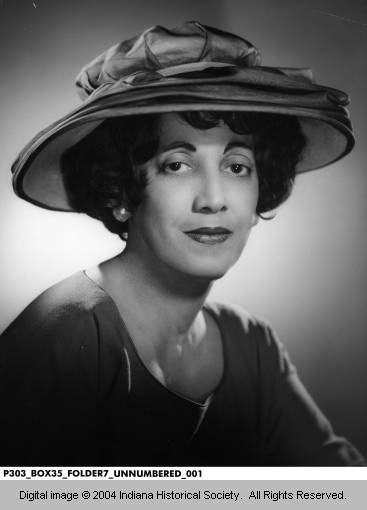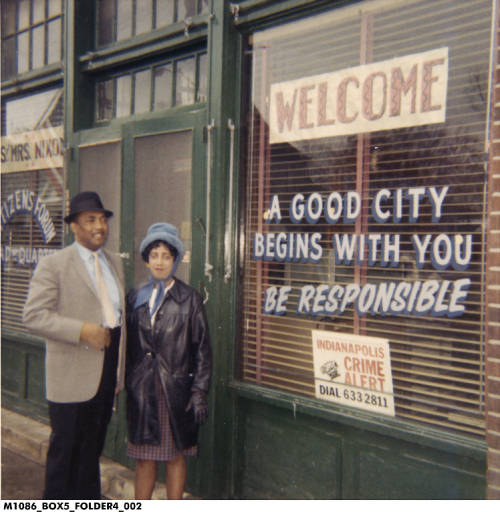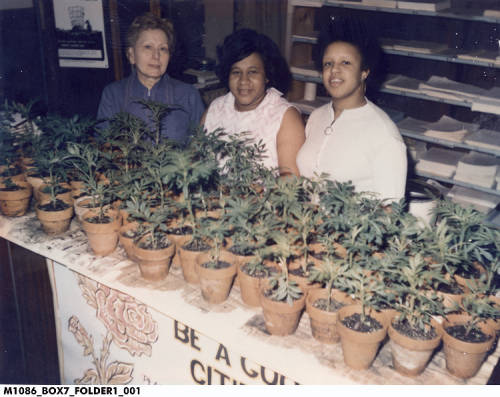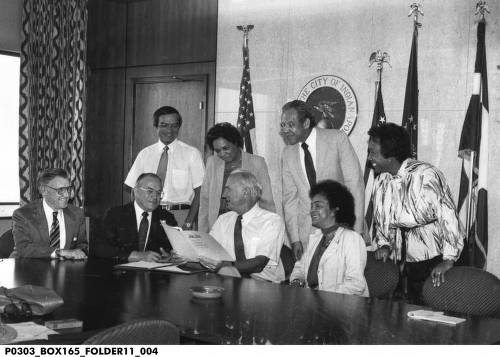
Plan your visit
The Lady in the Hat: Mattie Coney and Citizens Forum
November 20, 2020

Since leaving office at the end of his second term, former president Dwight D. Eisenhower had been living in retirement at a farm in Gettysburg, Pennsylvania. Although busy in 1967 with the publication of his final book, At Ease: Stories I Tell to Friends, Eisenhower took the time to write a personal letter to a former Indianapolis schoolteacher, Mattie Coney. From a number of sources, Eisenhower wrote Coney, as he had learned of an effort in the Hoosier capitol to clean and better the community’s neighborhoods. “Not only have I been impressed by our common sense philosophy,” he wrote, “but even more by the patriotism, energy, and organizing ability that are so evident in the record you have made.”
Eisenhower was one of many, among them Lady Bird Johnson and Gerald Ford, to lavish accolades on the efforts of Coney and the grassroots organization she helped create: Citizens Forum. Working with her husband, Elmo, and numerous Indianapolis residents and civic leaders, Coney attempted through her “Better Neighbor” program to encourage good citizenship, individual responsibility, and self improvement in inner-city neighborhoods.
From its inception in 1964 to its disbanding 20 years later, Citizens Forum, a racially integrated institution, organized thousands of block clubs throughout the city that embarked on such projects as the “De-RAT-ification” campaign to rid the city of rodents; the “Dogwood Tree” program to plant trees; the “Visit Your Neighbor Month”; a city-wide beautification program to remove trash from streets and yards; and a “Helping Hand” program, inaugurated in 1973 to provide children with safe havens on their way to and from school. Impressed with the group’s results, other cities—Chicago, Detroit, Milwaukee, New Orleans, New York, and Washington, D.C.—began similar efforts.

Elmo and Mattie Coney outside of Citizens Forum offices. Mattie Coney retired as a school teacher to found Citizens Forum, an organization dedicated to ending housing discrimination that focused on the power of the individual citizen to improve his or her own neighborhood. Photo credit Indiana Historical Society.
The driving force behind the successful neighborhood improvement association was Coney, known throughout central Indiana and the country for her stylish headgear, blunt opinions, and no-nonsense philosophies known as “Mattieisms.” Her outspokenness on the need for African Americans to “quit feeling sorry of ourselves and take advantage of our opportunities” and her belief that “slums are made by people, not by plaster or bricks,” often put her at odds with both white and black leaders struggling to achieve equal rights for African-American citizens during the 1960s, who viewed her as a willing tool of the establishment seeking to place the blame for poverty and racism on blacks themselves instead of on unfair laws.
Coney, who died in 1988, utilized a different approach than those used by such nationally prominent civil rights proponents as the Reverend Martin Luther King Jr. or more radical groups such as the Black Panthers. “I never believed in the need for marching, cussing, fussing and breaking up stuff,” said Coney. She acknowledged that not everyone agreed with her methods. “Many Negroes don’t like what I’m saying,” she said, noting that some went as far as to call her Aunt Jemima. “They think I’m blaming them. I’m not. I’m talking about all people, and if they happen to live in filth, then they ought to clean it up. I just tell the truth.” To Coney, a registered Republican, those who criticized her, white and black alike, did so because they liked to “talk about what’s wrong, not what’s right and how to make it better.”
Born in Gallatin, Tennessee, on May 30, 1909, Coney was an only child. When she was six weeks old, her family moved to Indianapolis, where her mother and father eventually divorced. Her mother, Delia, a cook, later married Oscar Weathers. The family lived in a two-story house west of Indiana Avenue. At an early age, Coney learned from her family the importance of hard work and self-reliance. “Our family always believed in the free enterprise system,” she said, noting that one uncle owned a milk business, two operated stands in the city market, one ran a successful barbershop, and another had the largest hot tamale business in town.
After graduating from Shortridge High School in 1927, Coney put herself through a two-year teacher training course at Butler University by delivering newspapers and working at the L. S. Ayres Tea Room. Embarking on a teaching career that would span more than thirty years, her first assignment was a class of 55 supposed incorrigible children that she soon turned into a group of model students with her own brand of education. Throughout her days with the Indianapolis public schools, she stressed solutions to the everyday practical problems facing her students. Students thrived in the atmosphere Coney created because “she expected you to live up to your potential,” said Pat Browne, a former pupil who went on to become a teacher herself. “When you got out of her class, you knew you were one of the best. You stood a little taller.”
Coney’s quest for perfection continued to drive her when she became involved with the creation of Citizens Forum. The inner-city neighborhood group evolved from a July 9, 1964, meeting held to discuss an open-housing ordinance being considered by the Indianapolis City Council. The ordinance prohibited real-estate agents from refusing to show homes or negotiate sales or rentals based on a person’s race, creed, color, or national origin.

Citizens Forum secretaries Martha Richeson, Debra Stanifield [?], and Diana Bailey Barnett work at a Bloom In table for Citizens Forum. Citizens Forum created many programs that aimed to improve the appearance of neighborhoods in Indianapolis. Photo credit Indiana Historical Society.
According to Coney, two city councilmen stopped by her home one evening to lament that realtors were using the alleged poor conditions of black neighborhoods as a wedge against the ordinance. Coney helped organize a citywide meeting of prominent black and white citizens, held at the Fall Creek Young Men’s Christian Association. “It was my hope,” she said of the meeting, “that we could talk among ourselves and work some of these problems out. It seemed to me that if I were a good citizen there shouldn’t be any reason because of my color, which I didn’t have anything to do with, that I couldn’t move to a neighborhood that was more comfortable.”
Working with her husband, Coney started efforts to improve area neighborhoods by organizing block clubs. By first educating block-club workers on how to become good citizens, Coney reasoned, they could, in turn, pass on those lessons through meetings at their homes. Members also kept an eye out on their areas, reporting health hazards and possible code violations to the proper city department, as well as welcoming new residents to the neighborhood.
In 1966 the 500 block clubs organized under the Citizens Forum banner gathered approximately 40,000 tons of trash from Indianapolis homes, streets and yards. The next year, the amount of refuse grew to 180,000 tons removed during a 28-day period. What made the program successful, according to Coney, who retired from teaching to devote herself full-time as Citizens Forum executive secretary, was its simplicity—“anybody can clean up their homes and be good citizens,” she said.
A flood of improvement projects poured from the Citizens Forums’ office. A “Go One Step Farther” campaign urged residents to sweep a foot beyond the curb to help prevent drainage problems; a “De-RAT-ificiation” effort worked to eliminate places where rats bred, nested, and ate; and a “Bloom-In” program encouraged those who had surplus seeds and flowers to donate them for redistribution. The group also served as a liaison between local residents and various agencies of city government. These efforts garnered for the organization, and for Coney, numerous state and national honors, including a Recognition Award from the Keep America Beautiful program. Other cities copied the group’s programs, something Coney called “the sincerest form of flattery.”

Mayor William Hudnut and other city officials meet with members of Citizens Forum to discuss the neighborhood group’s $90,000 budget deficit. Photo credit Indianapolis Recorder Collection, Indiana Historical Society.
After years of dedicated service to the Citizens Forum cause, the Coneys, faced with ill health, both retired from the organization in the early 1980s. Without the Coneys’ leadership, and plagued by financial problems, the group disbanded in 1984. Ironically, the organization’s success may have helped speed its demise. As city government began to take on some aspects of Citizens Forum programs—heavy trash pickup and neighborhood beautification, for example—grants and contributions began to wane.
Mattie Coney’s legacy of self-help and improvement, however, remains intact. As she said when she was asked about her work when she and her husband were presented keys to the city in 1983, her greatest accomplishment came in “getting people to realize you have to do something for yourself. The Declaration of Independence promises the pursuit of happiness. You got to work for it.”









